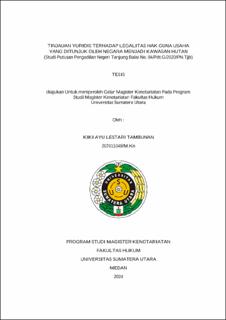| dc.description.abstract | A forest area is a specific region designated by the government to be maintained as a permanent forest. For an area to be classified as a forest area, it must go through four stages: designation, boundary setting, mapping, and establishment. Forest areas are regulated under Law No. 41 of 1999 on Forestry, Law No. 11 of 2020 on Job Creation (Forestry Cluster), and the Ministerial Decree No. 579/Menhut-11/2014 dated June 24, 2014, regarding Forest Areas in North Sumatra Province. According to this Ministerial Decree, many lands designated as forest areas were already occupied and utilized by individuals or legal entities under cultivation rights (Hak Guna Usaha). This research focuses on three main issues: first, the legality of cultivation rights designated by the government as forest areas; second, the legal protection for holders of cultivation rights within forest areas; and third, the resolution of forest area designations overlapping with cultivation rights.
This research adopts a normative descriptive approach. Data sources include library research and primary data, analyzed using qualitative analysis.
The findings indicate that the regulations related to forest areas in North Sumatra Province issued by the Ministry of Environment and Forestry show a significant overlap with lands holding land rights such as cultivation rights. In the Tanjung Balai District Court Decision No. 04/Pdt.G/2020/PN.Tjb, the judges considered the historical issuance of the cultivation rights, as these rights were granted before the forest area designation by the Ministry of Environment and Forestry. Consequently, the court concluded that PT. Sumber Sawit Makmur's land under cultivation rights was not within the forest area.
Furthermore, the resolution of overlapping forest areas and cultivation rights can be addressed by inventorying and identifying these lands. Lands along the boundary lines can be excluded from the forest area, and lands within the forest (enclave) can be removed through boundary adjustments conducted separately. Article 99 of the Minister of Environment and Forestry Regulation No. 7 of 2021 stipulates that land rights issued before the forest register map was published can be excluded from the forest area through clarification and verification by the relevant agency, in this case, the National Land Agency. | en_US |


